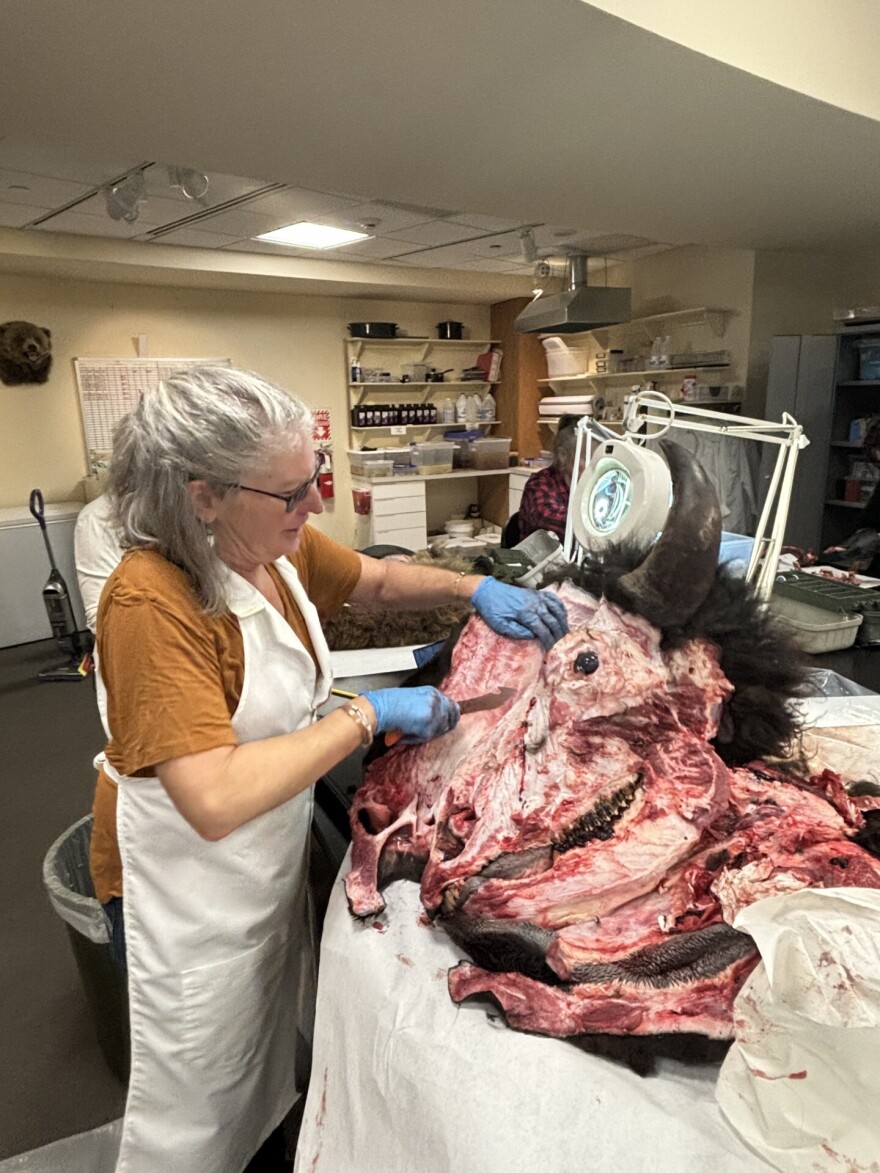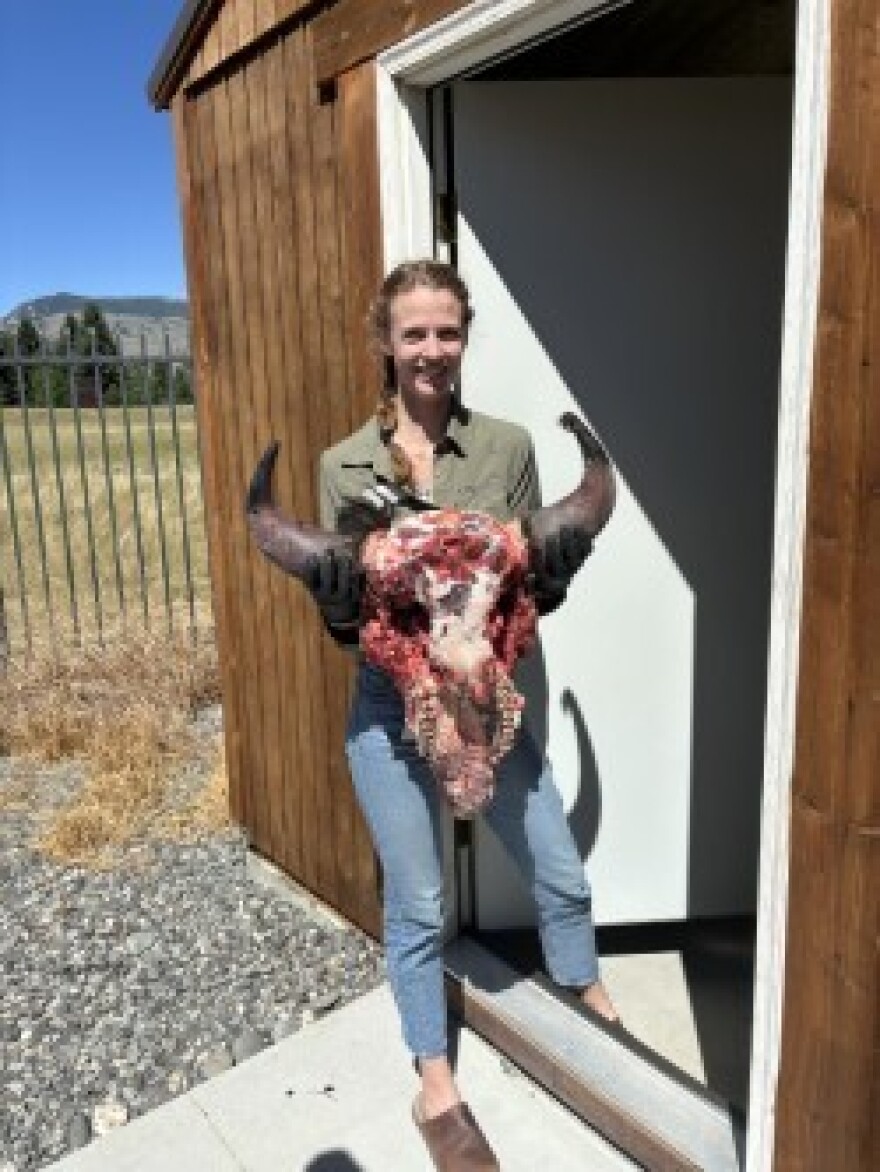Editor’s Note: This story includes descriptions and images of preparing an animal skeleton, and might be a little graphic for some readers.
Susan Bishop is in the lab at the Draper Natural History Museum in Cody, where a gigantic bison skull sits on a lab table.
Bishop skillfully moves her knife around the bison’s eye socket as she peels the skin away from the skull.
“ The skin is very thick, and I am trying to follow the contour of the bone, as opposed to skin it and then get down to the meat,” she said. “It's a challenge and nobody gets to see, or very few people get to see, what a bison skull looks like.”
Bishop is one of the volunteers helping to prepare this bison’s skeleton for display as part of the Buffalo Bill Center of the West’s “Buffalo Nation” exhibition opening next year. For months, staff, volunteers and flesh-eating beetles have been cleaning the bones to prepare to put them back together again.
Bishop said part of her challenge today is the insulated skin layer beneath the fur that keeps bison warm in the winter months. It’s about a half an inch thick and squishy.

She hands me some gloves and the scalpel, and I choose an area above the eye to get to work. Even though the knife was just sharpened, it’s a struggle to cut through the tissue and pull it away from the bone.
Curator Corey Anco explained people can only do so much when it comes to cleaning the bones. Articulating, or cleaning a skeleton, has multiple steps. He said the next part relies on furry insects.
“ Beetles consume all of that soft tissue inside, just leaving behind that porous, sponge-like skeletal tissue in the nasal cavity,” he said.
About six months after the lab day with the volunteers, I met up with Assistant Curator Amy Phillips. We went back to the lab to get the bison skull out of the freezer.
“We are gonna grab the bison skull from the bottom of freezer two, put it on a cart and take it to the beetles,” she said.
Phillips reaches into the chest freezer that’s kept at -2 degrees Fahrenheit. She removed the skull by the horns.
“It's the best way to hold it is by the horn cores. Now we've got our bison and he's ready to go into the bugs,” she said.
We head outside of the museum to a shed, which curators call the Beetle Bungalow. Inside, there’s a poster of the band the Beatles and two aquarium-like tanks full of bugs.

“Here's our skull that’s been partially cleaned by volunteers. And so we're gonna put the whole thing into the beetle colony. It's basically like a big birthday cake for the bugs because they'll have plenty of material,” she said.
Phillips gently sets the skull into the tank. Some of the larvae are millimeters long, while the older beetles are about the size of a Tic Tac. This variance in size allows the beetles to get into all of the nooks and crannies.
“Because we want to rebuild the skeleton, we're gonna be sawing into [and] putting wires where the bison's tendons would be. So it's helpful to have the bones really clean, because the glue and the adhesives that we use won't stick if there's fats or anything on them,” she said.
Phillips said spending time with the bison skull, you start to appreciate what bison actually do on the landscape.
“It has like this big heavy head and they use it for clearing snow in the winter time. It helps them as they dig through vegetation to get to what they want to eat,” she said.
Anco hopes that when the public gets to see all of the bones fit together, it’ll spark their curiosity: How does a bison move, and why do they have such a big hump on their back?
“All of us at some point have had building blocks, Lincoln Logs or Legos, to put together, and we got to see how things snap in place. Together, many small pieces make something much larger. And in the same way, to be able to see that in the context of a skeleton, it allows them to put some of these concepts of engineering at play with nature,” he said.
After the beetles finish their job, the bones get degreased in a bath of ammonium and then soaked in hydrogen peroxide for a light whitening.
For now, Anco said the bugs work better when they’re sung to.
“Here comes bison, here comes bison. And I'd say, it's all bone,” they sang, improvising the Beatles song “Here Comes the Sun.”
The public can come to watch and ask questions as staff and volunteers work with Lee “The Boneman” Post to reconstruct the bison skeleton. That’s at the Draper Natural History Museum in Cody on Aug. 4 through 15.
The bison skeleton will be on display as part of the Buffalo Nation exhibition in 2026.










